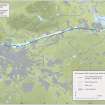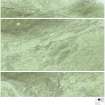Antonine Wall, Tentfield East
Signal Platform (Roman)
Site Name Antonine Wall, Tentfield East
Classification Signal Platform (Roman)
Alternative Name(s) Tentfield Expansion
Canmore ID 127414
Site Number NS87NE 5.01
NGR NS 8556 7981
Datum OSGB36 - NGR
Permalink http://canmore.org.uk/site/127414
- Council Falkirk
- Parish Falkirk
- Former Region Central
- Former District Falkirk
- Former County Stirlingshire
NS87NE 5.01 8556 7981
(See NS87NE 5.00)
There are two "expansions" projecting from the S face of the Antonine Wall rampart at Tentfield. They are to be compared with that at Bonnyside East (NS87NW 4) which was proved by excavation by the RCAHMS to have been a rectangular beacon stance, communicating with the area N of the Wall, its semi-circular shape in 1957 being due to the collapse of weathered turfwork.
The expansion at NS 8556 7981, was roughly semicircular, about 32' E-W at the rampart face by 18' N-S and 3' in height, mutilated on top by a large hole where a tree had been uprooted.
RCAHMS 1963, visited 1957; W Roy 1793; K A Steer 1959
The expansion at NS 8556 7990 is as described.
Surveyed at 1:2500.
Visited by OS (JLD) 29 January 1957
Publication Account (1985)
The finest surviving stretches of the Wall lie between Bonnyside House (NS 834798) and Watling Lodge (see no. 69), a distance of some 3km, and within this sector examples of most of the principal features of the Wall can be seen, as well as the major fort at Rough Castle (no. 71).
To the west of Lime Road the Wall itself is particularly well preserved and it still stands to a height of over 1m. Some 160 m west of Lime Road there is a beacon stance attached to the rear of the rampart (visible as a prominent mound projecting from the wall); another lies further to the west, a short distance east of the abandoned railway line, but it is more difficult to make out as it is partially obscured by trees in Tentfield Plantation. When the vegetation is low the line of the Military Way can be seen as a slight mound beginning a little to the north-east of the point where the road (B 816) crosses the railway; it can be traced for a short distance before being lost in Tentfield Plantation.
Information from ‘Exploring Scotland’s Heritage: The Clyde Estuary and Central Region’, (1985).










